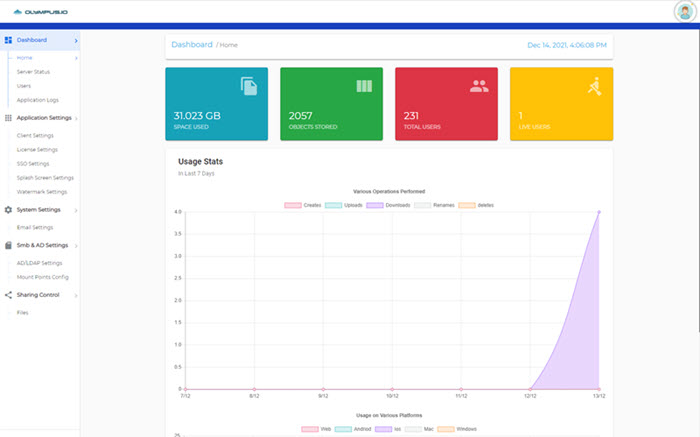
Take control with the Olympus.io SuperAdmin portal for managing your mobile file sharing environment
The application deploys as a Docker container or virtual machine on VMware ESXi or AWS, Azure and Google Cloud Platform. Recommended minimum VM size of 2 vCPU 4 GB RAM with 20 GB of disk will support hundreds of concurrent users. Scale-out deployments are also supported for High Availability environments supporting tens of thousands of users.
Olympus.io supports any SMB/CIFS or NFS file shares such as Microsoft Server or external Network Attached Storage vendors such as NetApp, Isilon, EMC, Pure and Hitachi. The Olympus.io SuperAdmin administration portal provides a secure web interface to mount the folders for sharing. Multiple filers can be mounted and integrated into a single external file sharing namespace.

- Multiprotocol file share mounting including SMB 2.0, SMB 3.0, NFS 3, NFS 4.1
- Mount files and folders with read-only or read-write access to enforce security
- All Active Directory and NTFS permissions are enforced. Remote users only are able to view folders for which they have Active Directory permission.
- Integrates with Single Sign-On for immediate password or user permission changes
Once mounted, the Olympus.io application scans and indexes the file shares. If connected to Active Directory, then all folder permissions are enforced so that users logging in only see the files for which they have Active Directory permissions. Users can search, browse and access file shares on mobile phones, laptops and tablets over secure HTTPS connections leveraging the latest NIST-compliant TLS encryption protocols to support HIPAA and FedRAMP compliance.
For added security and intellectual property protection, Olympus.io includes custom file watermarking capabilities for common file types. This can also be managed in the SuperAdmin portal. Watermarking includes IP address, date and time of access as well as the username of the downloading person.

If local files are locked due to editing, the remote users will be able to download, but not upload, read-only copies. If the user has local active directory read/write permissions, the remote user can upload data into the file share.
Guest users not in the active directory can be invited to collaborate onto existing file share folders with read or read/write access. Users first create a local account and then using 2-factor authentication can access the specified folder on your filer. This provides an easy, secure alternative to FTP servers for things such as marketing documents, customer service file uploads, business partner file shares, sales and engineering collaboration, investor relations and more.
The SuperAdmin dashboard provides overall system status including real-time statistics on user counts, storage indexed, file uploads, downloads, and access methods.

- Track uploads, downloads and remote access by users in real-time
- View total objects stored and storage across the entire file sharing platform
All user actions are logged by username, IP address, filename, access method (web, desktop or mobile app), action and timestamp within a searchable interface.

- Track uploads, downloads and remote access by username and timestamp
- Search across users by actions
- View IP addresses for all remote activities
- Track user client type – web, desktop or mobile apps
- Easily search document access and track any external sharing by username
Olympus.io VM Deployment Options
- On-premises or colo-based deployment
Olympus.io is deployed as a virtual machine inside your datacenter. A single Port 443 is opened in your DMZ for remote access. The Olympus.io app IP address is given a DNS entry such as “files.mycompany.com” and all inbound traffic from the Internet for that Domain resolves to the Olympus server. Local file servers are mounted to the Olympus.io VM in the SuperAdmin control panel. Remote users can then browse the secure file share using their existing Active Directory or SSO credential from their web browsers or mobile devices. - Public cloud based deployment
Olympus.io is deployed as a VM in your cloud account. Cloud file servers such as Cloud Volumes Service, Cloud Volumes ONTAP, Amazon FSxNetApp and Azure NetApp Files can be mounted as file mount points. These file mount points are indexed and made browsable by authenticated users over mobile devices.
High Availability Deployment
The Olympus.io application can be deployed as a 99.99% HA platform in both Active/Active and Active/Passive based configurations. Because the Olympus.io application only contains index information from the file shares, it is inherently stateless. No file data is ever stored in the Olympus.io application. All file data remains on the file shares ensuring no data loss even in the case of application VM disconnection.
Contact info@olympus.io for further sizing guidance.

